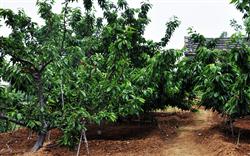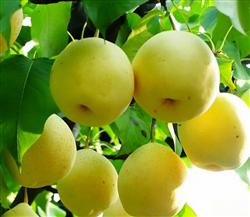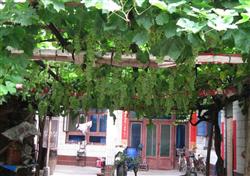Cherry planting techniques: how to manage and fertilize cherry orchards?

How to manage and fertilize cherry orchards? Please give introduction and guidance to introduce the following soil treatment and fertilization methods for cherry orchards for reference: 1. Soil management Soil management First of all, lay a good foundation before planting, especially mountain orchards, requiring horizontal terraces and digging pits for planting. After planting, it is necessary to continuously improve the soil. Under the condition that the fertilizer, water, gas and microorganism of the soil are good from the surface layer to the deep layer, the sweet cherry root system is developed and distributed deeply, which is beneficial to the growth and development of the aboveground part. 1. The soil layer of mountain orchard is generally shallow, the soil is barren, affecting the extension of root system; plain orchard, although the soil layer is thick, but the permeability is poor, through deep ploughing of hole expansion, the soil layer can be deepened, the ventilation condition can be improved, and the organic fertilizer can be applied to improve the soil structure, promote the activity of microorganisms, facilitate the growth of root system and improve the ability to absorb fertilizer and water. The method of deep turning: in the first few years after the young tree planting, starting from the edge of the planting hole, expanding outward every year or every other year, digging a circular ditch about 50 cm wide and 60 cm deep, digging out the stones in the ditch, filling with good soil and farm manure, gradually expanding until the deep turning ditch is connected between the two trees, and the root system of sweet cherry is also extended year by year. The deep turning of the hole will not damage the root system before the root system is extended. Deep plowing time can be in late autumn and early winter, after defoliation combined with autumn and winter fertilization. 2. Intertillage is a soil management measure during cherry growing season, usually after irrigation and rain. On the one hand, it can cut off soil capillaries, retain water, promote soil ventilation and prevent soil hardening; on the other hand, it can eliminate weeds and reduce competition between weeds and water and fertilizer. The depth of tillage is about 5 cm to prevent damage to thick roots. 3. During the period of orchard intercropping young trees, in order to make full use of land and sunshine and increase income, economic crops can be intercropped appropriately between rows. Intercropping crops should be dwarf, which is conducive to improving soil fertility crops, such as peanuts, mung beans and other legumes, and should not be intercropped with wheat, corn, sorghum, sweet potato and other crops that affect the growth of sweet cherries. When intercropping, leave enough tree plates and tree rows 2 meters wide. The intercropping time should not exceed 3 years at most, usually 1~2 years, in order not to affect the growth of trees. 4. The tree tray cover is to cover the cut weeds, wheat straw, corn straw, etc. on the soil surface under the tree, and the quantity is generally 2000~3000 kg per mu. If the grass source is insufficient, it can mainly cover the tree tray, and the thickness of the grass cover is 18~20 cm. The mulch can be done before the rainy season, and rain can fix the mulch so that the wind does not blow it away, while rain can promote the decay of the mulch. Tree cover has many advantages, first of all, it can preserve moisture, reduce soil surface transpiration, and maintain a relatively stable soil temperature. It can improve soil temperature in spring and autumn, and cool down in summer. Prevent high temperature damage to soil surface roots. More importantly, it can inhibit weeds, reduce weeding labor, increase soil organic matter, promote soil microbial activities, change soil physical and chemical properties, and facilitate root growth. The tree tray cover is most suitable for mountain orchard. Grazing is not recommended for flat orchards and waterlogged depressions with heavy soil, because it is easy to accumulate water in rainy season after mulching, causing waterlogging. In addition, in the treatment of insects, to hit the mulch at the same time, in order to eliminate pests lurking in the grass. 2. Rational fertilization 1. Fertilization period Cherry different age and different periods of fertilizer requirements are different, 3 years old below the juvenile tree, tree body in the crown expansion period, nutrient growth exuberant, this period of nitrogen requirements, should be mainly nitrogen fertilizer, auxiliary appropriate phosphate fertilizer, promote the formation of crown. 3~6 years old and early fruit stage young trees, to make the tree body from vegetative growth to reproductive growth, promote flower bud differentiation. Therefore, attention should be paid to nitrogen control, phosphorus increase and potassium supplement in fertilization. When trees over 7 years old enter the full fruit stage, the tree consumes more nutrients. The annual fertilizer application increases, nitrogen, phosphorus and potassium are needed, but potassium fertilizer should be supplemented at the fruit growth stage to improve the yield and quality of fruits. In the same period of one year, cherry fruit has the characteristics of rapid and concentrated fertilizer demand due to its short growth period. From leaf development, flowering, fruit development to maturity, all concentrated in April to June, while flower bud differentiation also concentrated in a short period after harvest. On the one hand, it requires strengthening fertilizer and water management in spring, on the other hand, it requires that the tree can accumulate a lot of nutrients in the first year to meet the needs of early spring growth and flowering. Therefore, two key periods of autumn fertilization and spring topdressing should be emphasized in cherry tree fertilization. 2. Before defoliation foliar fertilizer autumn (late September and early October), in the first half month of defoliation, can spray 2% urea, at this time leaves thick, low temperature, high urea concentration will not occur when the phytotoxicity, but spray time in the afternoon after 3 o'clock, autumn evening dew, conducive to foliar absorption. Cherry and other fruit trees are the same, before falling leaves will decompose the nutrients in the leaves into soluble state, and then transport to the branches and roots, so that branches and roots have more nutrient accumulation in winter, which is beneficial to enrich flower buds and enhance cold resistance. 3. Autumn base fertilizer autumn base fertilizer, generally in September to late October, application before defoliation is good, early application of base fertilizer is conducive to fertilizer ripening, the next spring can play an early fertilizer efficiency, scientists are conducive to root healing, improve the absorption capacity of roots, increase the nutrient reserves in trees. The amount of base fertilizer applied should account for 70% of the annual fertilizer application amount, and the fertilizer application amount should be determined according to the age, tree vigor, fruit yield and fertilizer type. Young trees are generally about 25~50 kg of manure per tree, and about 100 kg of manure per tree in full fruit period. The quantity of high-quality chicken, pig manure or human excrement can be less, and the quantity of soil compost such as weeds and leaves should be more. The method of applying base fertilizer is as follows: circular ditch can be used for young trees, and fertilizer can be applied in a ditch 50 cm wide and 40~50 cm deep at the projection of the outer periphery of the crown. It is best to use radiation ditch fertilization for big trees, that is, dig radiation ditch outward at 50 cm away from trunk, narrow inside and wide outside, shallow inside and deep outside, width and depth of one end near trunk 30 cm, far from trunk 40~50 cm, ditch length exceeding crown projection about 20 cm, the number of ditches is 4~6, and the position of fertilization ditch should be changed every year. 1. Circular fertilization 2. Radial fertilization 3. Digging and fertilizing ditches 4. Topdressing is carried out during the growth period of cherry trees, which is divided into two ways: soil topdressing and foliar fertilizer spraying. Topdressing is the main way of soil topdressing, which can be applied twice: once before flowering, compound fertilizer 1.5~2.5 kg, or human excrement 30 kg, urea 1.0 kg can also be applied to trees in full fruit stage, trenching topdressing and watering after application. This topdressing can promote flowering and leaf development, improve fruit setting rate and accelerate fruit growth; The second topdressing is after cherry fruit picking, when it is flower bud differentiation period, but also after flowering and fruiting, tree nutrition needs to be supplemented, each tree can be applied decomposed human manure 60~70 kg, or compound fertilizer 2 kg. The above fertilization methods can be applied in holes, furrows or irrigated into the rhizosphere under trees with watering. The effect of topdressing outside the root is fast, it is necessary for sweet cherries with short fruit growth period, and it is also a supplement to soil topdressing. Topdressing is concentrated in the period from flowering to fruit ripening, which is very useful to improve fruit setting rate, yield and quality. 0.3% urea can be sprayed before flowering, 0.3% borax can be sprayed at flowering stage, and 0.3% potassium dihydrogen phosphate can be sprayed 2~3 times from fruit expansion stage to coloring stage. In addition, it can spray the American Opur organic active liquid fertilizer produced by Beijing Shunyi Opur Biochemical Products Factory, spray 2~3 times with 600 times liquid, which is very effective for fruit coloring, improving sugar content and quality. Foliar fertilizer should be sprayed in the afternoon near evening, spraying parts to the back of the leaves, easy to absorb through the stomata of the leaves. Click for more cherry tree planting techniques Click for more fruit planting techniques
- Prev

Pear planting: how to manage pear trees in August?
How to manage the pear tree in August? Please introduce the management methods of pear trees in August can refer to the following methods for management: 1. Harvest: Bali, 20th century, August crisp, Cuifu pear, lucky water, red perfume and other medium-maturing varieties are harvested, and late-maturing varieties are ready. 2. The backbone branches of young trees are angled and.
- Next

Viticulture video: Garden viticulture video pictures
The use of courtyard and open space in front of and behind the house to cultivate grapes can not only increase economic benefits, but also relieve summer heat, shade and cool, green the courtyard and beautify the environment. Therefore, no matter in urban and rural houses, factories, schools and organs. Can use garden to plant grape, it is a very broad prospect of development sex lives...
Related
- Moge, come on! The staff of the peasant association in the producing area of cantaloupe were frightened when the crowd gathered.
- Causes and Solutions of low Fruit setting rate of Apple
- Symptoms and control measures of passion fruit virus disease
- Fruit growing lesson: how do apple orchards keep high yields?
- Can you build orchards in the mountains? What are the pros and cons?
- How to manage the coloring period of Crisson grape?
- This paper introduces the processing technology of two kinds of fig products.
- How much is a month for retired teachers in rural areas by 2020?
- How can strawberry planting increase sugar content? We should pay attention to management in many aspects.
- What are the cultivation techniques on how to improve the yield of golden fruit?

